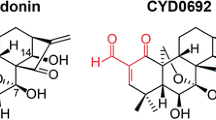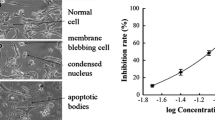Abstract
The structural relationship of 16 asiatic acid (AA) derivatives, including AA and asiaticoside (AS) to cytotoxicity and anti-hepatofibrotic activity in HSC-T6 cells, were investigated. Cytotoxicities of AA derivatives varied from 5.5 μM to over 2000 μM of IC50 depending on AA functional group modifications. Substituting the hydroxyl group at the C(2) to N=C and substituting bulky groups for dihydroxyl groups at (3), (23) of the A-ring increased the cytotoxicity, but keto group at C(11) and benzoyl ester at C(2) were greatly reduced it. Modification of the carboxylic acid group at C28 also reduced the cytotoxicity. The collagen synthesis determined by hydroxyproline content in the cells was inhibited from a maximum of 48% (Zlx-i-85 and 87) to 15% (AS) by AA derivatives. The anti-hepatofibrotic effect of these compounds might be due to the reduced expression of prolyl 4-hydroxylase α and β subunits and TIMP2. However, the inhibition of collagen by asiaticoside derivatives did not show any structural-activity relationship.
Similar content being viewed by others
References
Liu J, Liu Y, Mao Q., and Klaassen, C. D., The effects of 10 triterpenoid compounds on experimental liver injury in mice.Fundamental Appl. Toxicol., 22, 34–40 (1994).
Mook-Jung, I., Shin, J. E., Yun, S. H., Huh, K., Koh, J. Y.,, Park, H. K., Jew, S. S., and Jung, M. W., Protective effects of asiaticoside derivatives against beta-amyloid neurotoxicity.J. Neurosci. Res., 58, 417–425 (1999).
Maquart, F. X., Chastang, F., Simeon, A., Birembaut, P., Gillery, P., and Wegrowski, Y., Triterpenes fromCentella asiatica stimulate extracellular matrix accumulation in rat experimental wounds.Eur. J. Dermatol., 9, 289–296 (1999).
Shukla, A., Rasik, A. M., Jain, G. K., Shankar, R., Kulshrestha, D. K., and Dhawan, B. N.,In vitro andin vivo wound healing activity of asiaticoside isolated fromCentella asiatica. J. Ethnopharmacol., 65, 1–11 (1999).
Kwon, J., Lee, M., Cha K., Kim, J.-C., and Han J., Genotoxocity study if AS6, a triterpenoid derivative.J. Appl. Phamacol., 11, 190–195 (2003).
Han, J., Lee, M., Cha, S.-W., Im, D., Yang, B.-C., Lim, W.-H., Cha, K., Kim, J.-C., and Chun, M. K., Toxicity study of AS6, a triterpenoid derivative: 4-week repeated oral administration in rats.J. Appl. Phamacol., 11, 723–779 (2003).
Sampson, J. H., Raman, A., Karlsen, G., Navsaria, H., and Leigh, I. M.,In vitro keratinocyte antiproliferant effect ofCentella asiatica extract and triterpenoid saponins.Phytomedicine, 8, 230–235 (2001).
Qi, S., Xie, J., and Li, T., Effects of Asiaticoside on hypertrophic scars in a nude mice model.Zhonghua Shao Shang Za Zhi., 16, 53–56 (2000).
Lee, Y S., Jin, D. Q., Kwon, E. J., Park, S. H., Lee, E. S., Jeong, T. C., Nam, D. H., Huh, K., and Kim, J. A., Asiatic acid, a triterpene, induces apoptosis through intracellular Ca2+ release and enhanced expression of p53 in HepG2 human hepatoma cells.Cancer Lett., 186, 83–91 (2002).
Author information
Authors and Affiliations
Corresponding author
Rights and permissions
About this article
Cite this article
Dong, MS., Jung, SH., Kim, Hj. et al. Structure-related cytotoxicity and anti-hepatofibric effect of asiatic acid derivatives in rat hepatic stellate cell-line, HSC-T6. Arch Pharm Res 27, 512–517 (2004). https://doi.org/10.1007/BF02980124
Received:
Issue Date:
DOI: https://doi.org/10.1007/BF02980124




